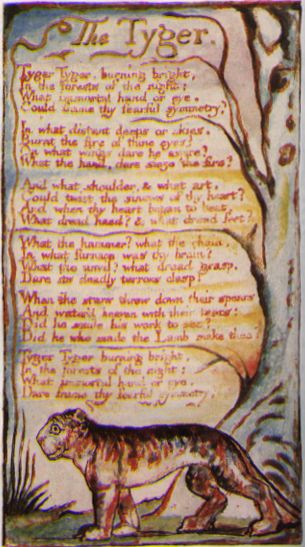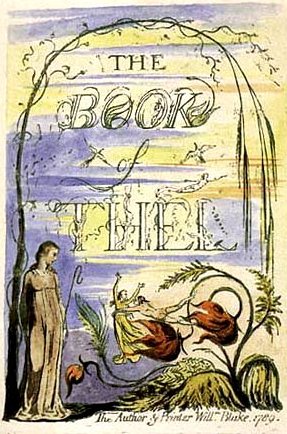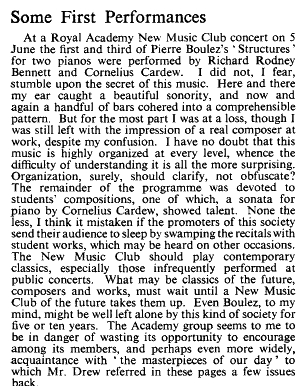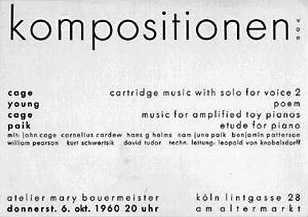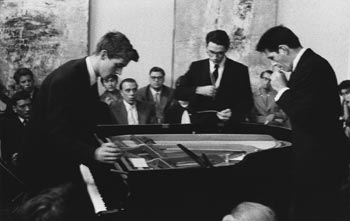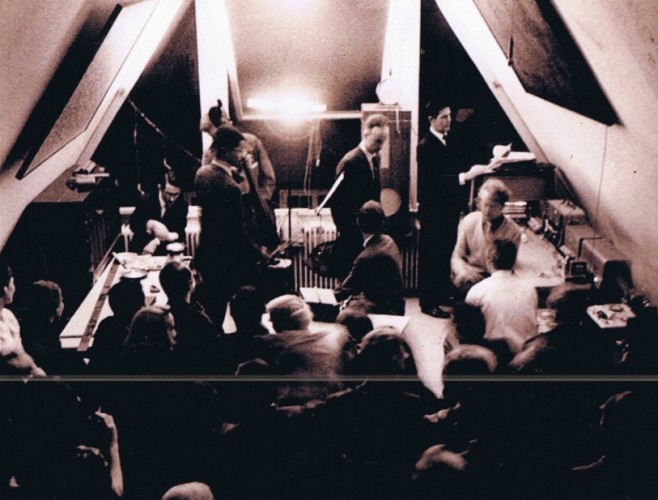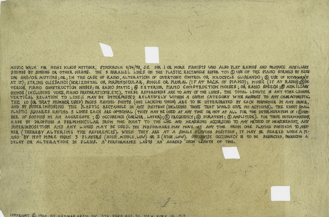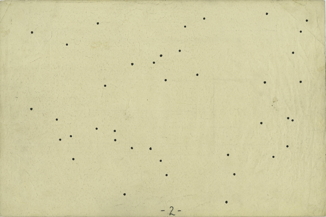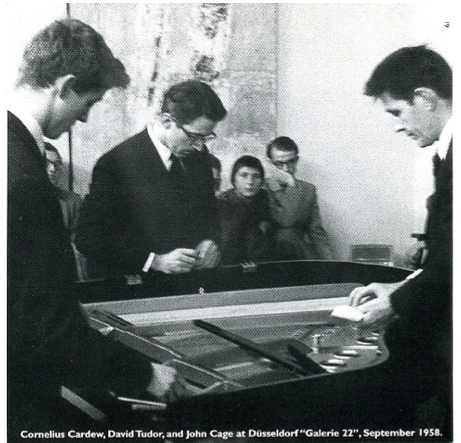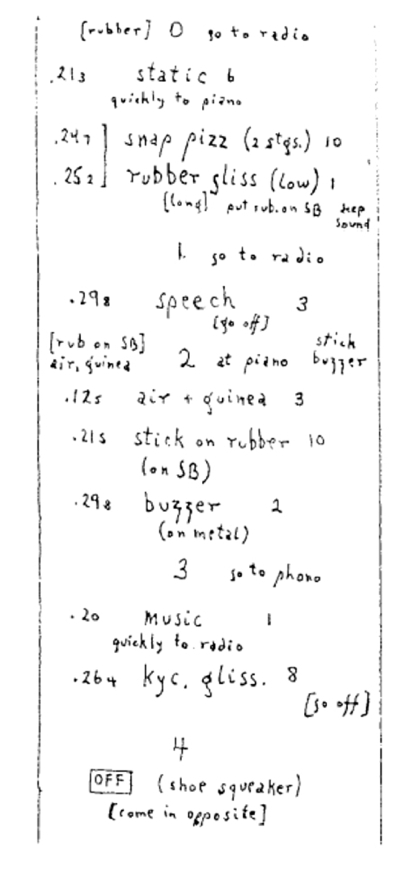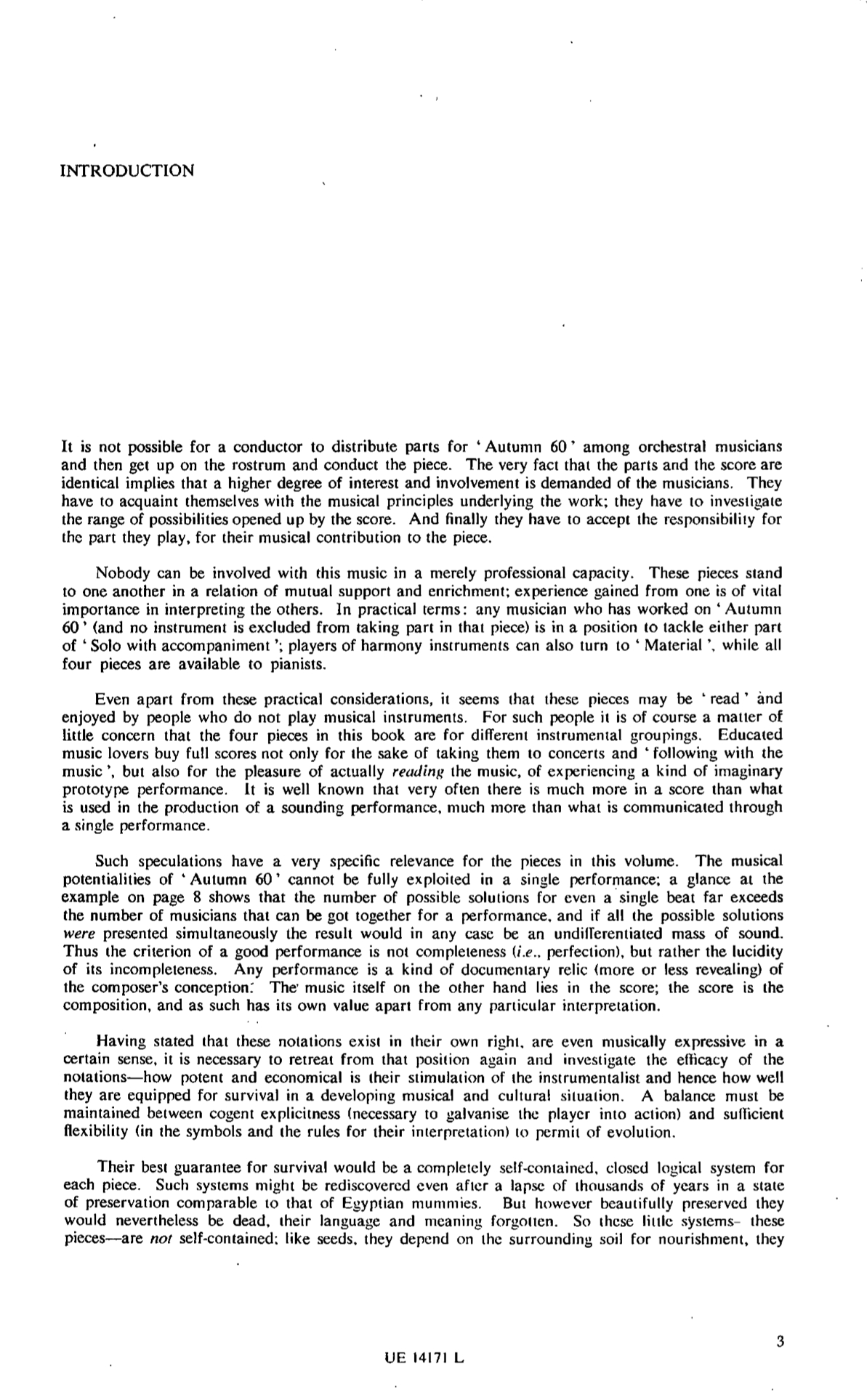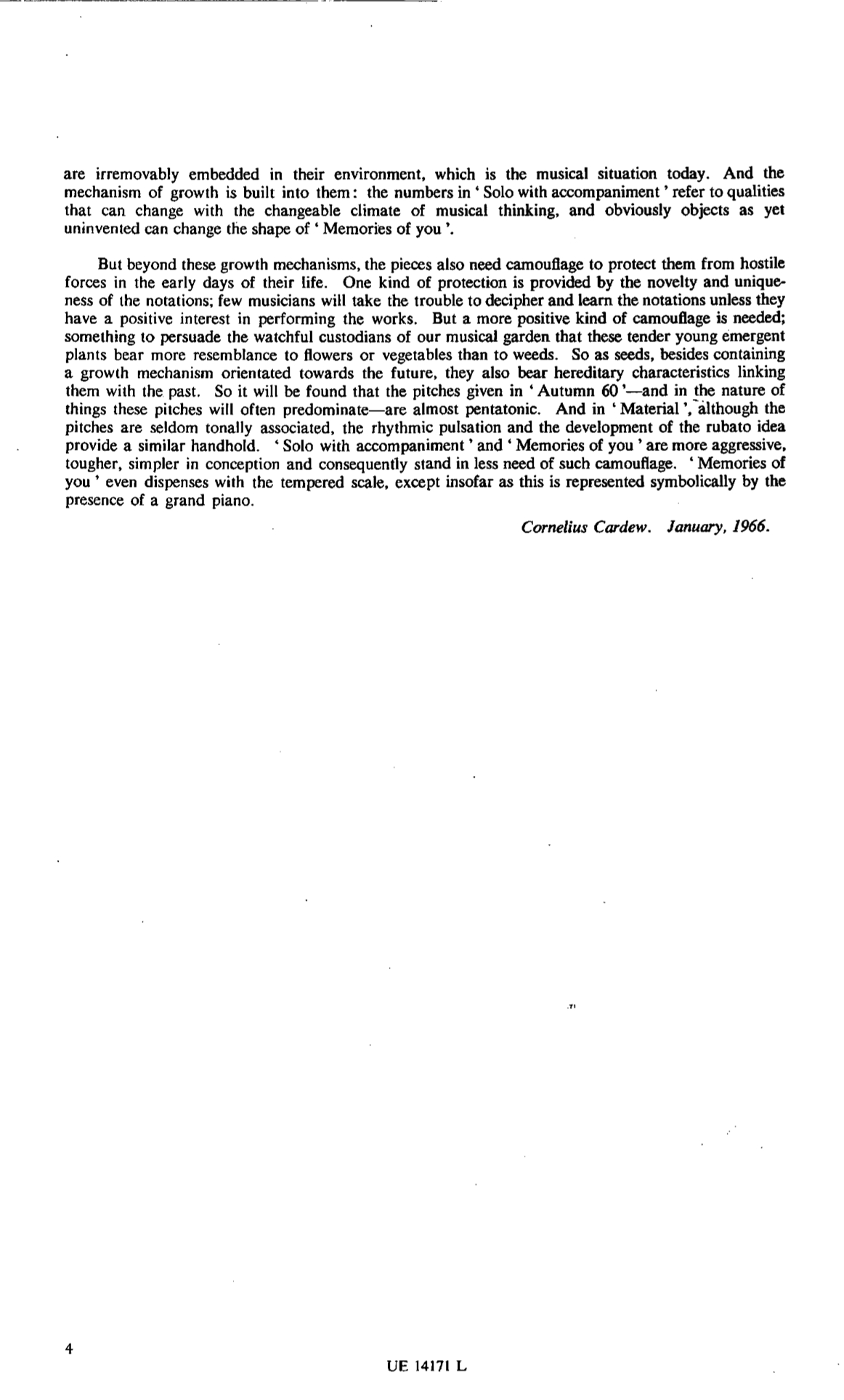> Studies > FAC-SIMILES
CORNELIUS CARDEW (AND FRIENDS)— AMM — The Scratch Orchestra —— Red Flame Proletarian Propaganda Team — People’s Liberation Music —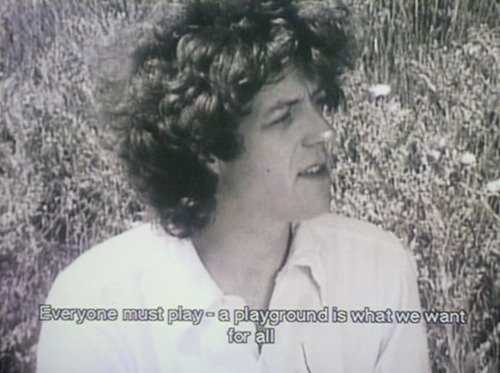
page 1 — 1958-1961page 2 (1961-1966) — page 3 (1966 - AMM) — page 4 (1968-1969) — page 5 (1969-1972) — page 6 (1972-1981)page 7 (list of works, references & concerts timeline) |
Articles connexes / Other Articles:
- CORNELIUS CARDEW (1936-1981)
- SCRATCH ORCHESTRA JOURNEYS (Cornelius Cardew) — bientôt / soon
- SCRATCH ORCHESTRA COTTAGE (Cornelius Cardew) — bientôt / soon
- SCRATCH ORCHESTRA VILLAGE CONCERTS (Cornelius Cardew) — bientôt / soon
- A Scratch Orchestra : Draft Constitution (1969) — Documentation
- Draft Constitution (June 1969) — Documentation
- Towards an Ethic of Improvisation (1971) — Documentation
- Stockhausen serves Imperialism & other texts (1974) — Documentation
- Cornelius Cardew (by John Tilbury) (1983) — Documentation
- CORNELIUS CARDEW — Sextet - The Tiger's Mind (1967) — Documentation
- CORNELIUS CARDEW — Volo Solo (1965) — Documentation
- CORNELIUS CARDEW — The East is Red (1964) — The East is Red (draft) (1964) — Documentation
- CORNELIUS CARDEW — Schooltime Composition (1968) — Documentation
- CORNELIUS CARDEW — Great Learning Paragraph 6 (1968-71) — Documentation
- CORNELIUS CARDEW — Great Learning Paragraph 7 (1968-71) — Documentation
This article is based on a compilation of various texts and papers by : Michael Parsons (1996), Brad Duncan (2008), Keri Davies (2010), Alan Parsons (2011), Robert Barry (2015), encyclopedia.com (2006), Richard Gott (2009), Sandra S. Smith (2011), James Weeks (2007), Virginia Anderson (2004), completed with various excerpts and quotations referenced into the text.
For more info, go to the references page
1958-1960(Edit)
|
It is not enough to decorate the world; the point is to influence it. Thus speaks Cornelius Cardew [following a sentence by Karl Marx ('It is not enough to understand the world, the point is to change it')], in his passionate and inflammatory tract Stockhausen Serves Imperialism, first published in 1974. It is a credo that runs through his life's work: music must stir up, awaken consciousness, and conscience, socialise, humanize. For Cardew, music was primarily about people: his lifelong commitment was to social music-making, from the ingenious notational stimuli of the Two Books of Study and Autumn '60, through the provocative beauty and obscurity of Treatise, the years of improvisation with AMM, the formation of the Scratch Orchestra and The Great Learning, and finally the decade of radical left-wing political activism before his early death in 1981. The theme of humanism, and the complex and sometimes contradictory development it undergoes in Cardew's work, guides the [musician and the listener] through the often labyrinthine twists of his restless, self-questioning thought. — (James Weeks, in Tempo, July 2007) 

|
Cornelius Cardew and William Blake (1757–1827) If the doors of perception were cleansed every thing would appear to man as it is, Infinite. For man has closed himself up, till he sees all things thro' narrow chinks of his cavern. — (William Blake, The Marriage of Heaven and Hell)
A setting of Blake’s On Another’s Sorrow dates from Cardew's teenage years. Most of Cardew’s compositions from this period make use of the serialist approach pioneered by Boulez and Stockhausen, including his two mature Blake settings. His biographer John Tilbury suggests that the choice of poet is significant, only partially explained by an artistic compatibility: “composer and poet shared concerns across a range of wider issues, both artistic and moral—in particular the dichotomy of impulse and spontaneity on the one hand and intellectual control and restraint on the other, and their perception of the reasoning faulty as potentially detractive of imagination”. Cardew’s significance is not just for musicians or for those interested in the fringes of left-wing politics, for Cardew being a good musician meant being a ‘real human being’. Like Blake, Cardew’s view of morality was based on integrity, of being true to oneself—a morality that was not imposed from without by a religion or a political party, but which came from within. John Tilbury writes : "Both Blake and Cardew praised inexplicitness in art, and their own was criticised for it. Blake for his failure to achieve sufficient control over his reader’s response, and Cardew for the failure of his notations to secure an accountable response from his performers. Both men regarded these ‘failures’ as virtues: ‘The wisest of the ancients considered what is not too Explicit as the fittest for instruction, because it rouses the faculties to act’. Blake’s belief in the inseparability of art and morality would also be echoed in the humanism embodied in Cardew’s notational experiments of the sixties … and the idea that participation is essential to finding value in life, even when it is destructive, is fundamental to the meaning of both Thel and to that of Cardew’s own life."
— Chorale: “On Another’s Sorrow”, [from Songs of Innocence]. Written c. 1948 (according to his brother Seth Cardew, but Tilbury suggests it may be a little later).
— Voice from Thel’s Grave (“Why cannot the Ear be closed to its own destruction?”) for high voice and piano, [words from The Book of Thel]. Written in 1957. Unpublished. First performed at the Aldeburgh Festival on 21 June 1957, with Josephine Nendick, soprano, and Cardew as pianist. A rigorously serial work, Voice from Thel’s Grave has an expressive vocal line using the kind of melismatic writing that Boulez had elaborated in Le Marteau sans Maître. As one might expect from a composer who was himself an exceptional pianist, the piano writing is demanding—using the whole range of the keyboard to create a variety of textures. Tilbury notes : "The dramatic opening of the poem is well served; the piano creates an appropriate atmosphere in the opening bars: music shrouded in dark colours, and at the climax, ‘Why a Nostril wide inhaling terror and affright?’ the piercing qualities of high percussive tones are effectively exploited."
— Ah Thel (“Ah Thel like a rainbow a rift in cloud”) for choir, SATB, with optional piano accompaniment, [words based on a part of The Book of Thel]. Written 1962. Published by Novello, 1963. Composed during the summer of 1962, Ah Thel appeared as a supplement in the Musical Times in July 1963. — [See next page] [Source : Keri Davies; "Blake Set to Music: Cornelius Cardew", 2010]
|
Cardew & Stockhausen(Edit)
|
Cornelius Cardew began his musical education as a chorister at Canterbury Cathedral, and later at King’s School Canterbury, joining in 1946 and continuing through 1950. His father was the potter Michael Cardew [other ref]. In 1953, at the age of 17, Cardew followed a boyhood passion for classical music all the way to the Royal Academy of Music. From 1953-57, Cardew studied piano with Percy Waller, cello, and composition with Howard Ferguson, and developed an interest in electronic music. A setting of Blake’s “On Another’s Sorrow” dates from his teenage years. Although Cardew proved an exceptional interpreter of Bach and Schubert, his natural dissidence soon led him to the European avant-garde – Webern, Boulez and Stockhausen –. The mecca for music students in those days was Stockhausen’s headquarters at Darmstadt, where the ‘Darmstadt Headbangers’ treated Britten and Shostakovich with derision as traditionalists, and serialism reigned supreme. After his graduation from the academy in 1957, at the age of 22, having won a scholarship to study at the Studio für Elektronische Musik des Westdeutschen Rundfunks (under Gottfried Michael Koenig), then considered the most advanced outpost of Western musical thought and practice, Cardew traveled to Germany and studied in Cologne with composer Karlheinz Stockhausen, known for his electronic compositions. He also worked as assistant with Gottfried Michael Koenig on Ligeti's electronic soundworks "Glissandi" (1957) and "Artikulation" in 1958. He continued on as Stockhausen's assistant from 1958-60, and the two collaborated on Stockhausen's multi-orchestral composition, Carré for 4 orchestras (1959-60). Stockhausen was opening up a new world of music making machinery, electronically generated sounds, and compositions that made full use of these developments. Their close creative relationship lasted for three years. "As a musician he was outstanding because he was not only a good pianist but also a good improviser and I hired him to become my assistant in the late 50s and he worked with me for over three years. I gave him work to do which I have never given to any other musician, which means to work with me on the score I was composing. He was one of the best examples that you can find among musicians because he was well informed about the latest theories of composition as well as being a performer". — (Karlheinz Stockhausen). For a year Cardew worked closely with Stockhausen, particularly on Carré. Stockhausen had work out the plans and had left a certain amount of latitude of discovering shapes or structures within given limits and provisions. Cardew undertook this work. In the realization of the score Cornelius Cardew worked out some of the composition plans independently. As Stockhausen noted : « The score was written in collaboration with Cornelius Cardew. » A close comparison can be made between this situation and that of the architect’s studio or with teaching in an artist’s atelier. Stockhausen conceived a kind of composition school, as nothing nor less than a kind of laboratory, an uninterrupted collaboration over a period of a few weeks, a teacher-pupil work team. But a second possibility of instruction in composition as it might be understood by Stockhausen is founded on the idea of collective work, such as was developed in his collaboration with Cardew and of which his touring ensemble is the most notable example to date. The participants would be selected composers, in other words those who have previously presented themselves to Stockhausen by sending in their scores. The collective work would have to be pursued throughout a long period of time. Here is an example of the work done on Carré : for a particular structure it is specified that it should last ‘very long’, and also the instruments, the pitches, the intensity and the nature of transformation processes are specified. The conductor change should take place, say, in the dynamics. For a chord of four specified pitches it is determined beforehand what forms should appear in the interpretation of the dynamic activity, and then - for instance - the form in which each note is brought out in turn from the chord is chosen. Thus Cardew was given the choice as to whether the first note or the second should be somewhat longer, in what order the notes should be played with a « crescendo », and which instrument was to be selected from the given sound family. Whilst Cardew worked in the afternoon after a preliminary discussion, Stockhausen could look through his realization in the evening and correct it. It would - in Stockhausen’s opinion - be possible to take such collective work much further than in the case of Carré : it might amount to an equal collaboration, each participant reacting to the other and constantly offering fresh stimuli. Such a form of cooperative work has scarcely ever existed in music between composers. The idea of teamwork as a stimulus and exchange led Stockhausen further. Teamwork should not in fact mean a mere repartition of work in which an organizer, leading the team, assigns work to subordinate assistants who are the executive organs. Much rather the idea is that composers should mutually incite each other to greater things and benefit from ‘feed-back’ by working together at a problem and constantly showing each other new ways of looking at it. Thus what might be achieved is more than a mere reciprocal information, but a contact, a complex interreaction; and it would be achieved by working on a completely new level. Composition would become not the sum of two possibilities but the product of mutual correction, modification and stimulation. — (Karl H. Wörner, "Stockhausen, Life and Work", University of California Press, 1963, pp. 231-232) |
DATES :
— 1956, London — June 5, 1956. Richard Bennett and Cornelius Cardew gave the first British performance of the first book of Pierre Boulez’s Structures pour deux pianos, a fourteen-minute work in three movements. Richard and Cornelius had worked assiduously almost every evening for six months to produce this feat of pianistic virtuosity to their tiny audience. Their triumph in conquering and performing Structures was somehow emblematic, a reminder of their three years as almost complete outsiders at the Academy. [Ref: Anthony Meredith, "Richard Rodney Bennett - the complete musician", London, Omnibus Press, 2010] Fac-Similes : (click to enlarge) |
 | During rehearsals of Carré by Karlheinz Stockhausen, Hamburg 1960. From left to right : Doris Stockhausen, [?], Cornelius Cardew, Karlheinz Stockhausen, Merce Cunningham, Herbert Hübner, Mauricio Kagel; behind: David Tudor, and on Kagel's right side: Andrej Markowski, Peter Schat, Alfred Schlee, Gertrud Meyer-Denkmann, Luciano Berio and Michael Gielen.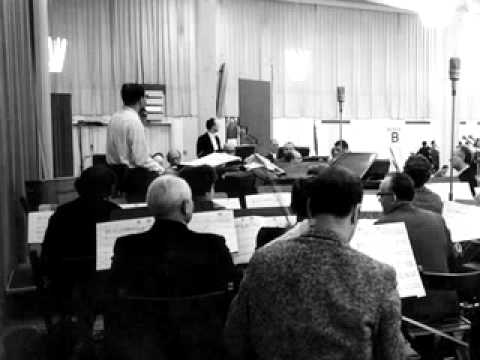 |
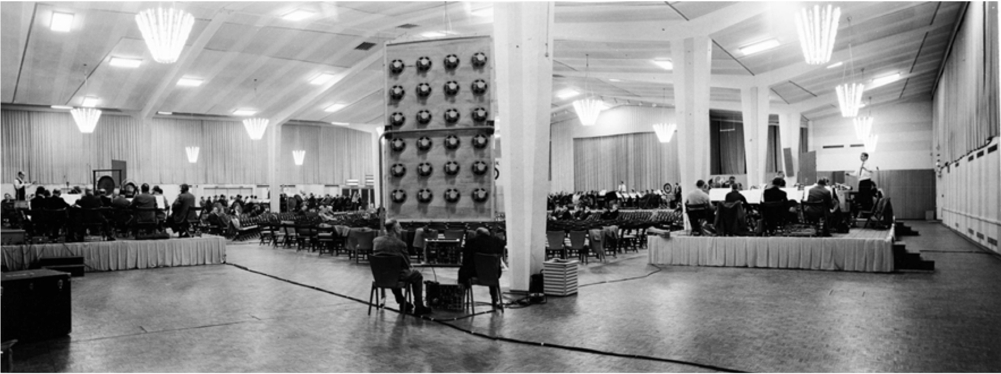 Dress rehearsal of Carré, Hamburg, Oct. 1960 |
| Cornelius Cardew — Report on Stockhausen's 'Carré’ - Part 1 The Musical Times - October 1961 (102/no.1424 (Oct. 1961): 619-22) — and Report on Stockhausen's 'Carré’ - Part 2 The Musical Times - November 1961 (102/no. 1425 (Nov. 1961): 698-700) Stockhausen's "Carré" for four orchestras was performed in Hamburg on October last year (1960). In this article Cornelius Cardew describes his experiences while collaborating with the composer on its creation and execution. [Download pdf ] [Read Stockhausen's Carré score (swf file)] | […] My collaboration with Karlheinz was, on the one hand, an expression of his altruistic desire to help me personally, and on the other, his solution of his problem of having more commitments than he could accomplish single handed. "Carré" was commissioned by Radio Hamburg, and was conceived during Karlheinz's long flights over North America while he was lecturing there. I had spent February and March at a loose end in England, writing February 1959 in odd moments, and making my final comment on my studies in electronic music in an article called « the unity of musical space »; returned to Cologne in April with an open mind and a work hungry spirit; and found a whole heap of more or less hieroglyphic notes, including 101 snappy items of the same generał form [...] (which I have freely invented, no longer having access to any of the material of "Carré"). These I proceeded to realise, working daily chez Stockhausen from 3pm until dinnertime, aided, irritated, confused, encouraged, and sometimes even guided by his own eagle eye, or his voluminous notes, or his random narrations as he worked on his experiments for what later became "Kontakte" (for piano, percussion, and four track track tape). At the end of three months or so, during which I also wrote my "Octet 1959" and learnt the guitar part of "le Marteau sans Maître" [by Boulez], a rough score had come into existence; I had an obscure idea of what the piece would be like, and Karlheinz's more whimsical notions about the piece had been abandoned, and all seemed set, when, on the eve of my return to England, Karlheinz sprang the idea of the 'insertions' (episodes outside the general run of the piece - at this stage they had very little in common with what they eventually became) which were to delay the completion of even the rough score until March 1960, when I finished the last page (containing 3,000 odd notes) of the last insertion (comprising ten or so such pages) in a sun fil leci library in Amsterdam. The 'story' of this piece is longer and more harrowing than the 'story' of any other piece I have written. Which says something about its value. I like the Yiennese painter who remarked - very pleased with himself- to a critic, 'Yes, a lot of work went into that picture.' 'Well isn't that just too bad,' was the reply, 'because none of it is ever going to come out again'. […] — [Continue reading (pdf) ] |
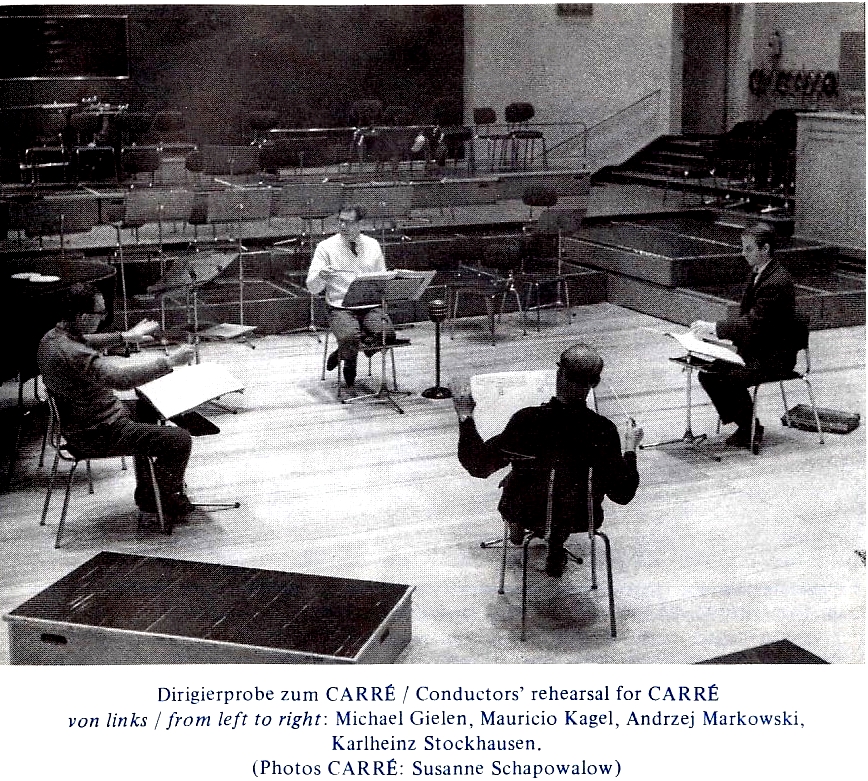 |
Cardew, composition and experimentalism(Edit)
|
In his first phase (ca. 1956-60), Cardew was an avant-garde composer who first studied with, then became assistant to, Karlheinz Stockhausen. In 1960, Cardew criticized Stockhausen’s authorial control (in ‘Report on Stockhausen’s Carré’, Musical Times 102/1424 and 1425 ) 1961) and turned to Cagean experimentalism. — (Virginia Anderson, ''Review of the Legacy of Cornelius Cardew by Tony Harris) While in Cologne, Cardew attended concerts given in 1958 by American avant-garde composer/pianists John Cage and David Tudor. He was deeply impressed by the freedom and openness of Cage's attitude to sound, and by the virtuosity and inventiveness of Tudor's playing. He became familiar with pieces such as Cage's Music of Changes, with the earlier work of Morton Feldman, Earle Brown and Christian Wolff, and soon afterwards with that of La Monte Young and Terry Riley. The freshness and informality of the new American music and its direct involvement with the physical realities of sound, the passage of time and the dynamics of performance opened up a perspective quite different from that of European serialism, with its complex and rigid notational controls. Cardew began to explore the implications of indeterminacy with much greater freedom: instead of trying to restrict and incorporate the methods of Cage and the other American composers, he took them further and extended them in new directions. These spurred his interest in experimental composition techniques, and he began writing a series of "indeterminate" pieces, including Autumn '60, Octet for Jasper Johns, Solo with Accompaniment, and Memories of You. He was concerned not only with liberating sounds from compositional control, but with creating new challenges for performers; he invited them, in effect, to become not only interpreters but also collaborators in the realisation of the music. During this time, Cardew also performed regularly, focusing on works by noted American avantgarde composers, including Cage and Christian Wolff. While promoting Cage’s music throughout the 1960s, he saw both composers, Cage and Stockhausen, as revolutionary. There were creative forces having an even greater impact on the young Cardew than Stockhausen and electronic music. Cardew visited the United States in the late 1950’s and attended a series of performances that would change his entire artistic trajectory. The U.S. composers John Cage and David Tudor were working at the height of their creative powers, incorporating chance, atypical instrumentation, and performance art into their compositions and public performances. Cardew’s encounter with their music was shattering for him. There was something unmistakable happening in the U.S. avant-garde and Cardew connected with it tremendously. Soon Cardew would act as a bridge between U.S. composers and British composers. He solidarized with what was becoming known as Minimalism, including the work of drone specialist La Monte Young. Embracing more than just Cage, Cardew connected with the entire web of fellow travelers: Christian Wolff, Morton Feldman, Earle Brown, as well as dancer and choreographer Merce Cunningham. Cardew was also very impacted by the extent to which these composers were connected to the visual arts. Ref : Wilfried Dörstel & al. (eds) Intermedial, Kontrovers, Experimentell: Das Atelier Mary Bauermeister in Köln 1960-162, Emons Verlag, 1993. Ref : Cornelius Cardew, '"On the role of the instructions in the interpretation of indeterminate music'', Treatise Handbook (London, etc.: Peters, 1971), p. XIV. |
DATES : |
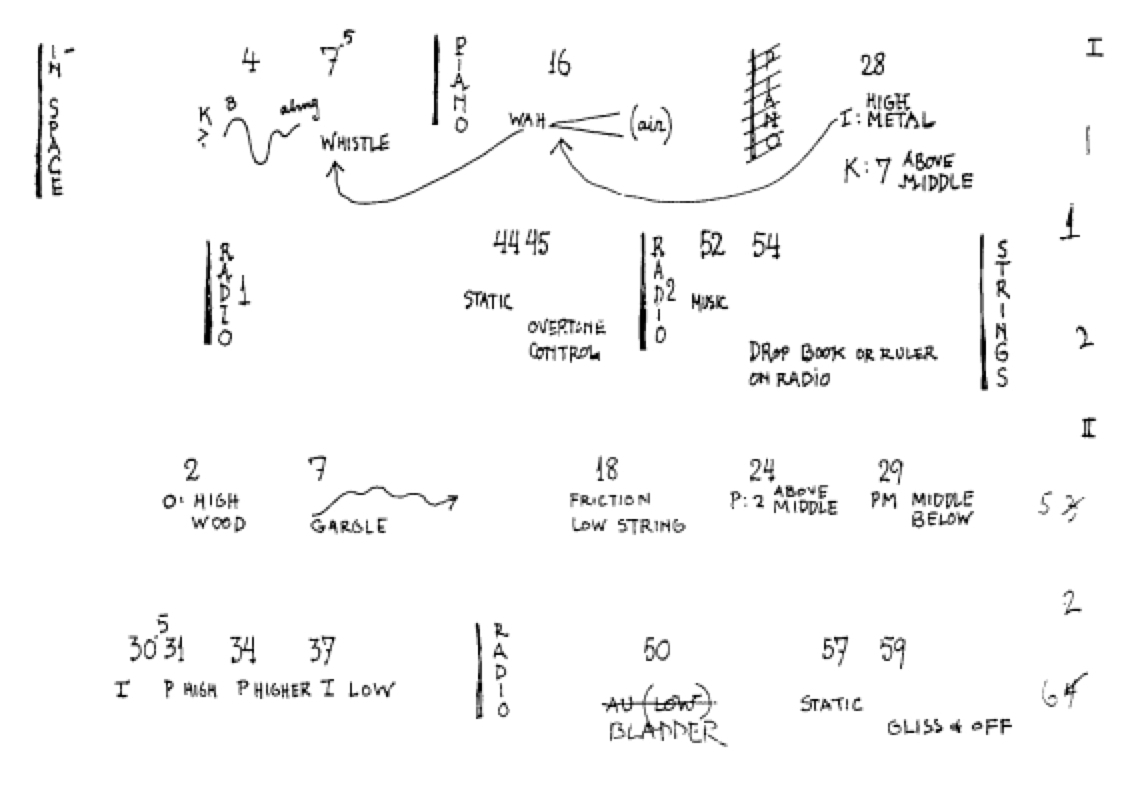
John Cage’s performance realization of « Music Walk » (1958), showing events of the fist two minutes. — Reproduced courtesy of the John Cage Estate
About John Cage’s Music Walk » (1958) :
— In James Pritchett, "The Music of John Cage", Music in the XXth Century, Press Syndicate of the University of Cambridge, 1993
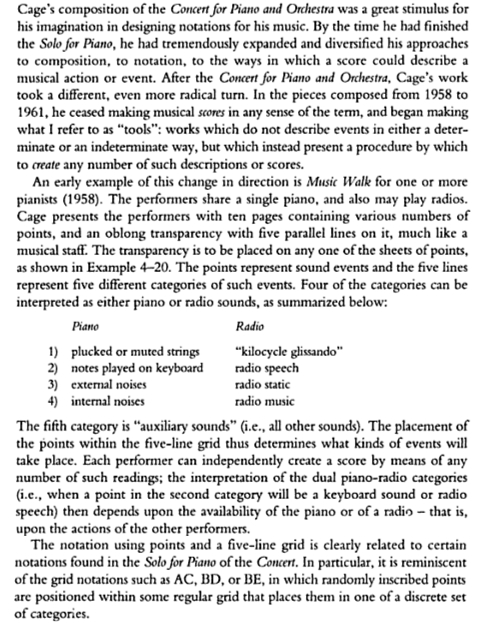 | 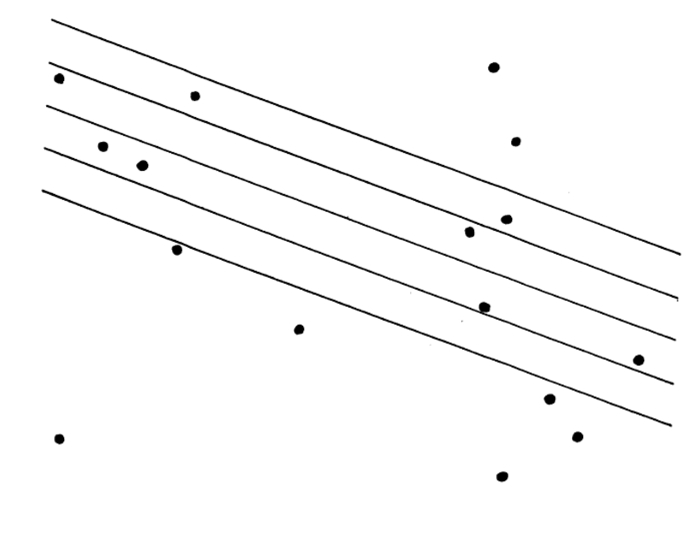 |
Atelier Bauermeister, Cologne, March 26, 1960 :
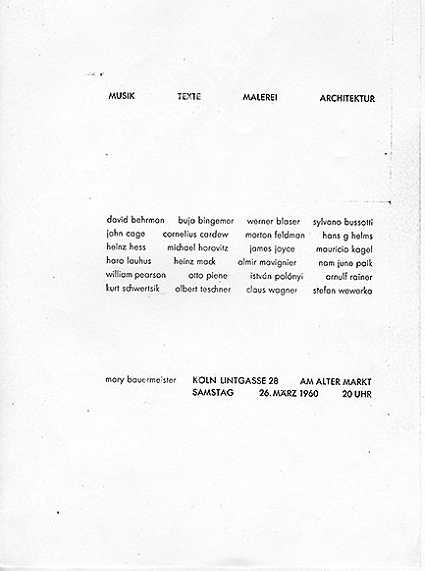 url : (archive Mary Bauermeister) - Fac-Similés : (cliquer les images pour les agrandir / click to enlarge) |  url : (archive Mary Bauermeister) 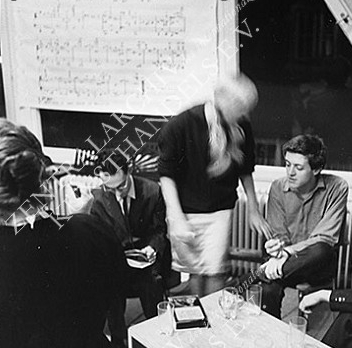 url : (archive Mary Bauermeister) | 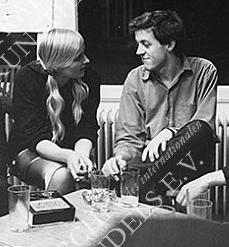 url : (archive Mary Bauermeister) 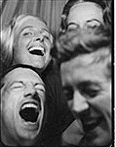 Mary Bauermeister, Pyla Patterson, Haro Lauhus und Cornelius Cardew url : (archive Mary Bauermeister) |
Atelier Bauermeister, Cologne, June 18, 1960 :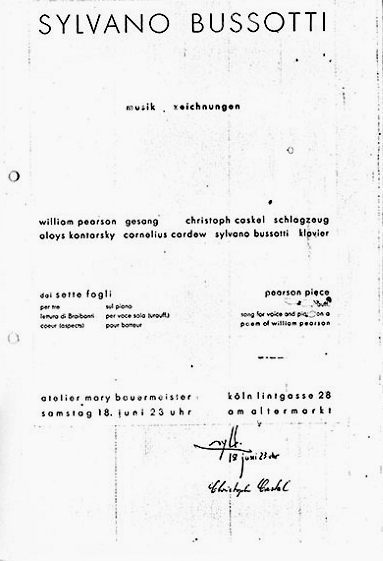 url : (archive Mary Bauermeister) | Atelier Bauermeister, Cologne, Oct. 6, 1960 :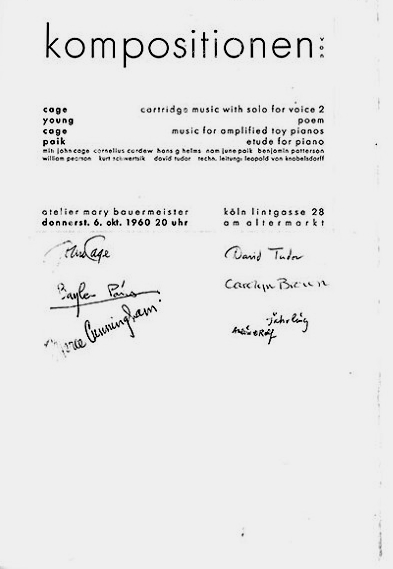 url : (archive Mary Bauermeister) |
Cardew, Autumn '60(Edit)
|
Cornelius Cardew's music of the '60s is arguably from his most creative and experimental period as a composer, beginning with Autumn 60 and ending with the last paragraphs of The Great Learning in 1970. This decade can be divided into two parts, where the first half focuses on indeterminate music and the latter sees a growing emphasis on improvisation. Treatise functions as a bridge between these two periods as it contains elements of both. Autumn ’60 is a work for undetermined instrumental ensemble. It is Cardew's first indeterminate score. It is often performed with larger ensembles, but also works well in a smaller format. It was premiered by a quartet consisting of the composer on guitar and John Cage on piano amongst others. Autumn '60 is "for orchestra", but the identity of that orchestra is variable. Although most performances have probably been for chamber groups, the score is as usable, potentially, by a single soloist on a lonely woodblock as by an orchestra of late romantic scale and proportions. The score, which all players receive, features a system with two staves, the upper consisting of one to seven conventional markings — clefs, notes (which are limited to f, gb, ab, bb, and db), articulations, ornaments, instrument names, dynamics, etc. — assigned to the quarter note beats of simple meters, from which individual players are to extract their own parts and enter into the lower staff. The score provides the performers with a variety of possibilities - of pitch, timbre, and dynamics - on which the performers base an improvisation. This occurs in a variety of ways : not only do the performers use the given elements as the basis for their musical ideas, but also they have the option of « avoiding » the given material. The process of part extraction appears, at first, to be rather open, but it gradually reveals itself to be in many ways quite constrained, in particular through the instruction to "ignore any two of the indications for any particular beat" as well as those combinations of notation which lead to an instruction to "play nothing", each of which might serve to create a kind of negative space around the material identity of the piece. The degree of cooperation in part preparation between the players is not specified; indeed, the parts may be extracted in complete independence, and further independence is introduced by the interventions of a conductor, who also uses the score to prepare a part, in which details of form, tempo, rubato, ensemble composition and texture, and even additional degrees of performer liberty may be introduced. The process Cardew stipulates for the making of performance decisions is perhaps arbitrarily complex - real-time improvisation is impossible, and in practice each performer needs to prepare a thought-out response to the indeterminate score. This perhaps is the essence of Autumn ’60 - Cardew found new ways of enabling performers to bring their musical intelligence to the process of interpretation. Cardew’s work demands an active intelligence, one attuned to the aural reality of the musical product - in particular the activity of fellow performers - at least as much as the abstract compositional « intention ». Here is a critical distinction between such works of Cardew and contemporaneous works of Cage and others - while indeterminate, « chance » is not an issue in Autumn ’60. On the contrary, Cardew successfully found a vehicle for genuine collaborative composition, one in which the artificial (and historically short-lived) distinction between the « composer » and « performer » was abandoned. Cardew’s early work that empowers performers with the responsibility for the creative act certainly has resonance with his political ideas, that later were to come to the fore. — (Jonathan Poles, Daniel Wolf) Cardew makes it clear that a very active participation is required with these pieces; the performer has to be an active interpreter, on a par, at times, with the composer: "Nobody" he says, "can be involved with this music in a merely professional capacity." Standing at the head of these compositions is Autumn 60. It is a brilliant exercise in persuading individual participation. It consists of a chain of various sections, in which each beat of every bar holds often contradictory performing instructions, potentially generating differing musical events. As Cardew explains: "The musical potentialities of Autumn 60 cannot be fully exploited in a single performance the number of possible solutions for even a single beat far exceeds the number of musicians that can be got together for a performance." The implications of a piece like Autumn 60 might parallel what Umberto Eco referred to as a 'work-in-movement' - work which is never 'closed', a performative event in which composer and performers unite in working within the piece's various limitations: "The 'work-in-movement' is the possibility of numerous different personal interventions, but it is not an amorphous invitation to indiscriminate participation. The invitation offers the performer the opportunity for an oriented insertion into something which always remains the world intended by the author." What was the world intended by Cardew for Autumn '60 ? Generally, the generated sound world has a fragmented, pointillistic atmosphere. Tying in with Eco's description, Cardew reminds us: "The criterion of a good performance is not completeness (i.e. perfection) but rather the lucidity of its incompleteness." This holds true for Autumn 60 and the other works in this set. Material, rather than exploring timbral discontinuities or interconnections, concentrates more on harmonic density and rhythmic flexibility. These pieces, [like Autumn '60, Solo with Accompaniment, Memories of You, and Material], create a coherent and cohesive statement of Cardew's approach to indeterminacy. They set in motion his dual attention to extreme pragmatism and philosophical, even utopian, ideals. They are subtle essays in how one might initiate a skeletal framework to be fleshed out, to be made corporeal, by future generations. Cardew referred to this as 'growth mechanisms': i.e. how changing performance practice and musical outlooks can be accommodated by compositional activity. It is a balance between 'cogent explicitness' and 'sufficient flexibility' rather than a fully notated 'self contained' piece: "The best guarantee for survival would be a completely self contained, closed logical system for each piece. Such systems might be rediscovered, even after a lapse of thousands of years, in a state of preservation comparable to Egyptian mummies. But however beautifully preserved they would nevertheless be dead, their language and meaning forgotten. So these little systems - these pieces - are not self contained; like seeds, they depend on the surrounding soil for nourishment, they are irremovably embedded in their environment which is the musical situation today." In this work the conductor subverts his normal role: he can give clear beats or vague beats, increase or decrease tempi, change the order of sections and even stop conducting altogether. The players are also allowed the possibility of ignoring or observing the written music and signs, as well as introducing their own material into the performance. Cardew maintains a skeleton of his own pitch material which will, by chance, remain just in and out of focus. — (David Ryan 2001) |
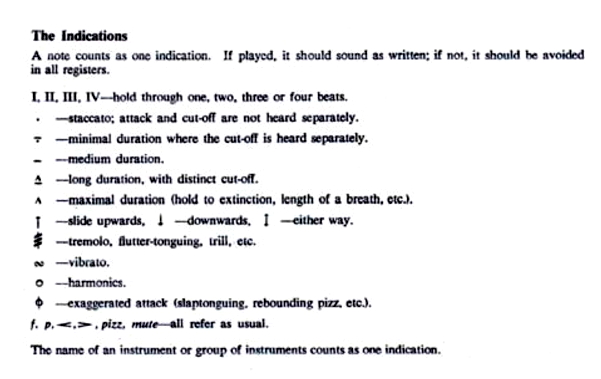
Indications :
Three systems from the first of the five pages of Cardew’s ''Autumn ’60''. AUDIO
Cornelius Cardew — Autumn '60, for variable ensemble — (ca 10mn)
John Tilbury (piano), Michael Duch (contrebasse), Rhodri Davies (harpe) This version was arranged and conducted by John Tilbury. Recorded live at Dokkhuset, Trondheim, 2010 Source : Plus3db Records VIDEO Play for Today: Cornelius Cardew Conference, two-day symposium, ICA, London 21 November 2009 - 22 November 2009 |
- Edward Venn — Cornelius Cardew's ‘Autumn '60 For Orchestra’ —
- URL(s) (pdf) : http://eprints.lancs.ac.uk/23011/1/download3.pdf
In Tempo / Volume 60 / Issue 238 / October 2006, pp 2-7. Cambridge University Press 2006. DOI: http://dx.doi.org/10.1017/S0040298206000271
- Cornelius Cardew, Towards an Ethic of Improvisation, —
- URL(s) : http://www.ubu.com/papers/cardew_ethics.html
Treatise Handbook (London, etc.: Peters, 1971), p. XIV.
Cornelius Cardew, About Autumn '60, January 1966
| Score : Four Works Publisher : London : Universal Edition, ©1967 Publisher's no.: UE 14171. Includes performance notes in English and German. Content : — Autumn '60 : for orchestra — Material : for any ensemble of harmony instruments — Solo with accompaniment — Memories of you : piano solo. http://www.worldcat.org/title/four-works/oclc/1445193 | Source : Autumn '60 : for orchestra Publisher : [London] : Institute of Contemporary Arts, ©1963. Universal Edition UE 14171 L Published from the 1962 Hinrischen Edition publication. Notes vary from those later printed with score as Universal Edition UE 14171 L in 1967. |
